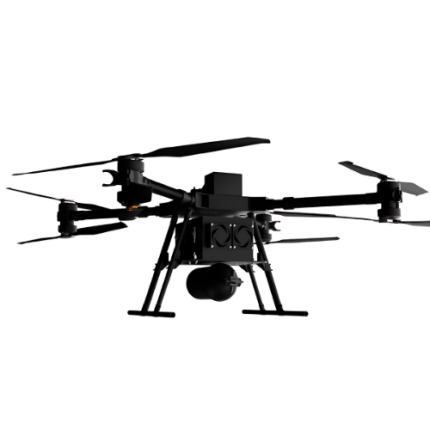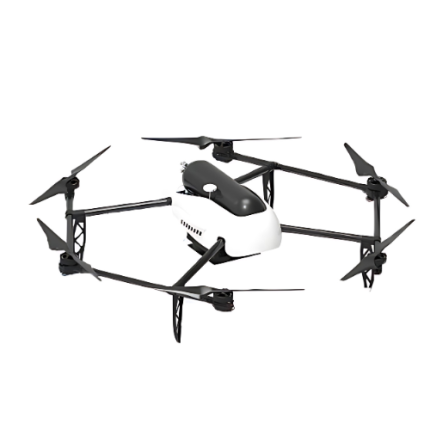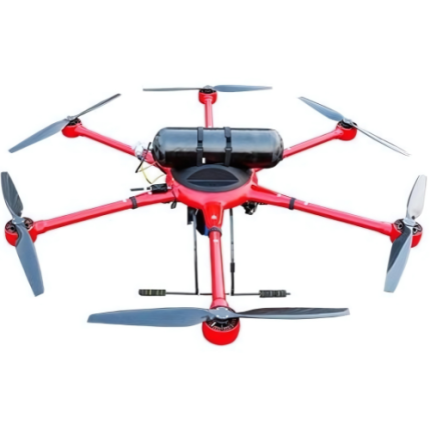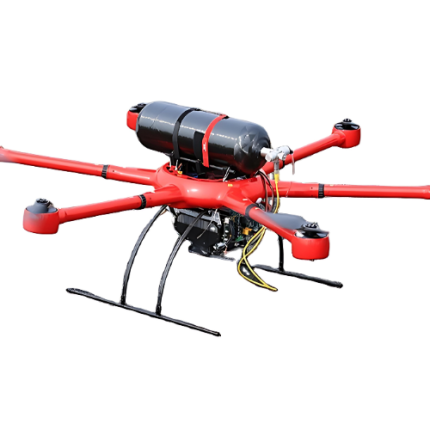GAO’s Hydrogen Fuel Cell Drones are unmanned aerial vehicles (UAV) powered by a hydrogen fuel cell, offering extended flight times compared to traditional battery-powered drones. The fuel cell generates electricity through an electrochemical reaction between hydrogen and oxygen, producing only water and heat as byproducts, making it environmentally friendly. These drones are equipped with lightweight composite tanks to store hydrogen, enhancing their energy density and efficiency. Ideal for long-range missions, such as surveillance, mapping, and agricultural monitoring, hydrogen fuel cell drones provide a reliable alternative to fossil fuel-powered UAVs. Combining high-energy efficiency, reduced emissions, and longer operational periods makes them a promising solution for advanced aerial applications in various industries.
The Hydrogen Fuel Cell Drone may also be called: Hydrogen-powered drones, Fuel cell UAVs (Unmanned Aerial Vehicles), Hydrogen UAVs, H2 fuel cell drones, Hydrogen energy drones, Hydrogen cell drones, Fuel cell-powered drones, Hydrogen-fueled drones, Hydrogen-electric drones, and Hydrogen-powered UAVs
GAOTek 4-Axis 8-Rotor Wing Hydrogen Powered Fuel Cell Drone/UAV- Flight Mode
GAOTek Air Cooled Hydrogen Fuel Cell UAV/Drone-Non Pollution
GAOTek Electric Multi-Function Hydrogen Fuel Cell Drone/UAV-Payload
GAOTek Outdoor Inspection Function Hydrogen Fuel Cell Drone/UAV- Flight Long
GAOTek Widely Application Hydrogen Fuel Cell Drone/UAV- Leakproof
GAO’s Hydrogen Fuel Cell Drone is composed of the following components:
- Hydrogen fuel cell stack
- Hydrogen storage tanks
- Electric propulsion system (motors and propellers)
- Power management system
- Flight control unit
- Battery (for hybrid configurations and power smoothing)
- Sensors (e.g., GPS, IMU)
- Communication systems (e.g., telemetry, RF modules)
- Airframe and structural components
- Cooling system
- Power electronics (e.g., converters, regulators)
- Landing gear
- Payload attachments
GAO Tek’s Hydrogen Fuel Cell Drone has the following functions:
- Extended Flight Time: One of the primary functions of hydrogen fuel cell drones is to provide significantly longer flight times compared to battery-powered counterparts. Hydrogen fuel cells offer higher energy density, allowing drones to operate for hours instead of minutes, which is particularly beneficial for applications requiring prolonged airborne activity.
- Increased Payload Capacity: GAO’s hydrogen fuel cell systems are more efficient in terms of weight-to-energy ratio, enabling drones to carry heavier payloads without compromising flight performance. This makes them suitable for tasks such as cargo delivery, search and rescue missions, and carrying advanced sensor equipment.
- Rapid Refueling: Unlike batteries that require lengthy charging times, our hydrogen fuel cell drones can be refueled quickly. Refueling a hydrogen tank typically takes only a few minutes, allowing drones to return to operation faster, which is crucial for time-sensitive missions and continuous operations.
- Environmental Sustainability: This hydrogen fuel cells produce zero carbon emissions, emitting only water vapor as a byproduct. This function supports environmentally friendly operations and compliance with stringent environmental regulations, making these drones suitable for use in ecologically sensitive areas.
- Consistent Power Output: The hydrogen fuel cells provide a steady and consistent power output throughout the drone's operation. This ensures reliable performance without the power drop-offs commonly associated with lithium-ion batteries as they deplete, maintaining optimal functionality for the duration of the flight.
- High Energy Efficiency: The efficiency of hydrogen fuel cells translates to better energy utilization. This function allows drones to perform more energy-intensive tasks without the frequent need for power replenishment, enhancing overall operational efficiency.
- Longer Operational Range: With extended flight times and increased energy efficiency, hydrogen fuel cell drones can cover greater distances on a single refueling. This expanded operational range is advantageous for applications such as border patrol, pipeline inspection, and large-area surveying.
- Reduced Operational Costs: Over the long term, our hydrogen fuel cell drones can be more cost-effective than battery-powered drones. The reduced need for frequent battery replacements and the potential for lower energy costs with hydrogen fuel contribute to overall cost savings.
- Cold Weather Performance: The hydrogen fuel cells perform well in cold weather conditions, where traditional batteries often suffer from reduced efficiency and capacity. This makes hydrogen fuel cell drones suitable for operations in harsh, low-temperature environments.
- Quiet Operation: The hydrogen fuel cells operate quietly compared to internal combustion engines. This function is beneficial for applications requiring low noise levels, such as wildlife monitoring, urban operations, and residential area surveillance.
- Advanced Sensor Integration: Our enhanced payload capacity and extended flight times allow hydrogen fuel cell drones to carry and utilize advanced sensors for a variety of applications, including high-resolution cameras, LiDAR systems, and multi-spectral sensors. This supports complex data collection and analysis tasks.
GAO Tek’s Hydrogen Fuel Cell Drone comply with applicable industry standards such as:
- ISO 14687
- ISO 22734
- ISO 16111
- IEC 62282
- FAA Regulations (Part 107)
- UN 3480/3481
- ANSI/CSA HGV 4.3
- NFPA 2
- ASTM F2910
- ASTM F3005
Our Hydrogen Fuel Cell Drone helps our customers comply with relevant U.S. government regulations such as:
- FAA Part 107
- FAA Part 135
- FAA Part 91
- EPA regulations
- DOT Hazardous Materials Regulations (HMR)
- OSHA standards
- FCC regulations
- DHS regulations
- NFPA 2
Our Hydrogen Fuel Cell Drone helps our customers comply with relevant Canadian government regulations such as:
- Transport Canada CARs Part IX
- Transport Canada CARs Part VI, Subpart 3
- Canadian Aviation Regulations (CARs) Part IV
- Transport of Dangerous Goods (TDG) Regulations
- Environment and Climate Change Canada (ECCC) regulations
- Canadian Standards Association (CSA) Standards
- Innovation, Science and Economic Development Canada (ISED) regulations
- Canadian Environmental Protection Act (CEPA)
- Workplace Hazardous Materials Information System (WHMIS)
- Canadian Nuclear Safety Commission (CNSC) regulations (if applicable)
Our Hydrogen Fuel Cell Drone has the following applications:
- Long-Duration Surveillance and Monitoring: GAO’s hydrogen fuel cell drones are ideal for extended surveillance missions, such as border security, wildlife monitoring, and maritime patrols. Their ability to remain airborne for extended periods allows for continuous monitoring of large areas, reducing the need for frequent re-deployment or battery changes.
- Infrastructure Inspection: These drones are used for inspecting critical infrastructure, including power lines, bridges, and pipelines. The extended flight time and high payload capacity allow for detailed inspections with advanced sensors, cameras, and LiDAR systems, providing comprehensive data without interruptions.
- Search and Rescue Operations: In search and rescue missions, our hydrogen fuel cell drones can cover vast areas and remain operational for long durations. They are equipped with thermal imaging and high-resolution cameras to locate missing persons or assess disaster-stricken areas, enhancing the efficiency and effectiveness of rescue operations.
- Agricultural Management: In agriculture, our hydrogen fuel cell drones can be used for precision farming tasks such as crop monitoring, soil analysis, and pest detection. Their extended flight capabilities allow for comprehensive surveys of large farms, improving data collection and decision-making processes for farmers.
- Environmental Monitoring: These drones are employed in environmental research and conservation efforts, such as monitoring air and water quality, tracking wildlife movements, and assessing deforestation. Their long endurance supports extended field studies and remote area inspections, contributing to more accurate environmental assessments.
- Disaster Response: In the aftermath of natural disasters, our hydrogen fuel cell drones can be deployed for damage assessment, search and rescue, and delivery of essential supplies. Their ability to operate for extended periods and cover large areas is critical for efficient disaster response and recovery operations.
- Telecommunications Infrastructure: GAO Tek hydrogen fuel cell drones assist in inspecting and maintaining telecommunications infrastructure, such as cell towers and antennas. They can perform routine inspections and identify potential issues without the need for extensive ground support or repeated flights.
- Urban and Smart City Applications: These drones can be integrated into smart city initiatives for tasks such as traffic monitoring, public safety, and infrastructure management. Their long endurance and quiet operation make them suitable for urban environments where frequent data collection and continuous monitoring are required.
- Scientific Research: In scientific research, our hydrogen fuel cell drones are used for collecting data in remote or challenging environments, such as polar regions or high-altitude areas. Their extended flight time and ability to carry advanced research instruments support in-depth studies and experiments.
- Delivery Services: Our hydrogen fuel cell drones have the potential to revolutionize logistics and delivery services by enabling long-range, high-capacity deliveries. They can transport goods, medical supplies, or essential items over longer distances without the limitations of conventional battery-powered drones.
- Film and Media Production: In the film and media industry, hydrogen fuel cell drones are utilized for capturing high-quality aerial footage over extended periods. Their ability to stay airborne for longer durations allows for creative and dynamic shots that enhance visual storytelling.
Below are our resource pages containing useful information on Hydrogen Fuel Cell Drones:
FAQ on Hydrogen Fuel Cell Drone
How to choose Hydrogen Fuel Cell Drones
Components of Hydrogen Fuel Cell Drones
Operation, Maintenance & Calibration of Hydrogen Fuel Cell Drones
Customers of Hydrogen Fuel Cell Drones in the U.S. and Canada
Our Hydrogen Fuel Cell Drones are in stock and can be shipped overnight within the continental U.S. and Canada from a nearby warehouse in the U.S. or Canada. They can also be shipped globally.
We provide 24/7 support. If you have any questions, our technical experts can help you. Please fill out this form or email us.










